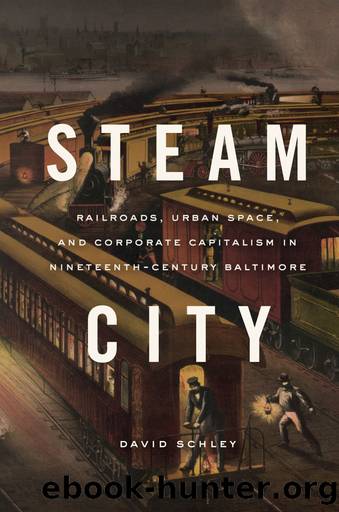Steam City by David Schley

Author:David Schley [Schley, David]
Language: eng
Format: epub
Tags: HIS000000 History / General
Publisher: University of Chicago Press
Published: 2020-10-06T00:00:00+00:00
Systems for Through Trade
The tunnel systemâs origins lay in the rivalry between the B&O and the Pennsylvania Railroad. In 1858, Marylandâs legislature chartered a line called the Baltimore & Potomac (B&P) to link southern Maryland with Baltimore. The B&P charter contained a provision allowing the construction of branch lines, including one to the District of Columbia. This drew the attention of the Pennsylvania Railroad, which purchased the B&P in 1867 with an eye to breaking the B&Oâs monopoly on travel to and from the capital. As the Pennsylvania had already acquired the Northern Central, the B&P would complete its through route from New York City to Washington.51
When the city council authorized this new construction in 1869, it sought to make the new line as inconspicuous as possible. The B&P branched off from the tracks of the Northern Central in North Baltimore and passed through well-heeled residential districts in the northwestern part of the city before turning south to the capital. The ordinance authorizing the B&P to lay its tracks specified that all rails within the city limits would run below street grade in tunnels or deep cuts. The council charged the company with keeping its trains âentirely concealed from the view of persons using the streets,â ordered that steam ventilation take place âwithout annoyance to persons or property in proximity thereto,â and demanded that conductors use bells, not whistles, for signaling purposes, so as not to disturb the railroadâs neighbors. The ordinance also insisted that the B&P tunnel under or bridge over all the principal thoroughfares into town once it left the city limits. The company agreed to these strictures and the plans went forward despite opposition from residents of North Baltimore, who worried that the new rail infrastructure would harm their property and hamper movement uptown.52
The B&Pâs tunnels and deep cuts represented one half of a new subterranean crosstown rail route. The other half was the Union Railroad, a short line financed in part by the city government, which ran partially belowground through northeast Baltimore before turning south outside the city limits to terminate at the wharves of the Canton industrial complex.53 Together, the B&P and Union Railroad system, completed by 1873 at the cost of around $5 million, allowed western freight to reach tidewater without breaking bulk. Transfers that took a day by surface rail in horse-drawn cars could move through town in as little as ninety minutes via the tunnels. More broadly, though, the new through routeâs sponsors, including both the rail corporations and the municipality, contended that this underground system advanced a new vision for the city. The costly work of digging ventilated tunnels and building bridges represented a step toward, in the words of the Union Railroadâs president (and former B&O president) William G. Harrison, âremov[ing] from the now crowded streets the passage of trains.â54
For the railroads, going below the city avoided the troubles attendant with urban space and regulation. For urbanites, too, putting the tracks out of sight opened up the possibility of a new urbanism marked by expansion and free movement.
Download
This site does not store any files on its server. We only index and link to content provided by other sites. Please contact the content providers to delete copyright contents if any and email us, we'll remove relevant links or contents immediately.
| Automotive | Engineering |
| Transportation |
Whiskies Galore by Ian Buxton(41529)
Introduction to Aircraft Design (Cambridge Aerospace Series) by John P. Fielding(32888)
Small Unmanned Fixed-wing Aircraft Design by Andrew J. Keane Andras Sobester James P. Scanlan & András Sóbester & James P. Scanlan(32573)
Craft Beer for the Homebrewer by Michael Agnew(17933)
Turbulence by E. J. Noyes(7700)
The Complete Stick Figure Physics Tutorials by Allen Sarah(7137)
Kaplan MCAT General Chemistry Review by Kaplan(6595)
The Thirst by Nesbo Jo(6435)
Bad Blood by John Carreyrou(6274)
Modelling of Convective Heat and Mass Transfer in Rotating Flows by Igor V. Shevchuk(6222)
Learning SQL by Alan Beaulieu(6035)
Weapons of Math Destruction by Cathy O'Neil(5828)
Man-made Catastrophes and Risk Information Concealment by Dmitry Chernov & Didier Sornette(5646)
Digital Minimalism by Cal Newport;(5389)
Life 3.0: Being Human in the Age of Artificial Intelligence by Tegmark Max(5184)
iGen by Jean M. Twenge(5161)
Secrets of Antigravity Propulsion: Tesla, UFOs, and Classified Aerospace Technology by Ph.D. Paul A. Laviolette(4990)
Design of Trajectory Optimization Approach for Space Maneuver Vehicle Skip Entry Problems by Runqi Chai & Al Savvaris & Antonios Tsourdos & Senchun Chai(4839)
Electronic Devices & Circuits by Jacob Millman & Christos C. Halkias(4747)
